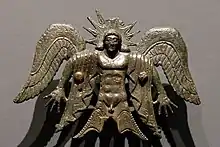Usil
Usil is the Etruscan god of the sun, shown to be identified with Apulu (Apollo). His iconic depiction features Usil rising out of the sea, with a fireball in either outstretched hand, on an engraved Etruscan bronze mirror in late Archaic style, formerly on the Roman antiquities market.[1] On Etruscan mirrors in the Classical style, Usil appears with an aureole.

He was identified with Apulu; appearing on an Etruscan mirror from the Vatican dating from the 4th century BC, on which Usil is seen holding the bow of Apulu.[2]
Usil was identified with the Roman Sol and Greek Helios. However, while Usil is depicted as male in some artwork, there are also feminine depictions.[3][4] There is also a connection with the indigenous Etruscan goddess Catha, who has been interpreted as having a solar character, however she has also been identified with a Lunar character.[5] In artwork, Usil is shown in close association with the dawn goddess Thesan, something almost never seen with Helios and Eos.[6]
Catha has been identified as "Solis Filia" meaning "Sun's Daughter", making Usil her father.[7]
In the Liver of Piacenza
Since his name appears on the bronze liver of Piacenza, next to Tiur, meaning both "moon" and "month",[8] since then Tiur has been identified as the name of the personification of the moon, but it was most likely a date. The inscriptions on the Pyrgi Tablets confirm that "tiur" was meant as "month" for datations,[9].
See also
References
- Noted by J. D. Beazley, "The World of the Etruscan Mirror" The Journal of Hellenic Studies 69 (1949:1–17) p. 3, fig. 1.
- Nonoss 2015.
- Haynes 2000.
- De Grummond 2008.
- de Grummond, Nancy T. (2008). "Moon over Pyrgi: Catha, an Etruscan Lunar Goddess?". American Journal of Archaeology. 112 (3): 419–428. doi:10.3764/aja.112.3.419. ISSN 0002-9114. JSTOR 20627480. S2CID 193046316.
- De Grummond & Simon 2006.
- de Grummond, Nancy Thomson (2004). "For the Mother and for the Daughter: Some Thoughts on Dedications from Etruria and Praeneste". Hesperia Supplements. 33: 351–370. ISSN 1064-1173. JSTOR 1354077.
- Bonfante & Swaddling 2006.
- Adiego 2016, p. 155.
Bibliography
- Adiego (2016). "The Etruscan Texts of the Pyrgi Golden Tablets: Certainties and Uncertainties". In Bellelli, Vincenzo; Xella, Paolo (eds.). Le lamine di Pyrgi: Nuovi studi sulle iscizione in etrusco e in fenicio nel cinquantenario della scoperta. Vol. I–X. Verona. p. 155.
{{cite book}}: CS1 maint: location missing publisher (link) - Bonfante, Larissa; Swaddling, Judith (2006). Etruscan Myths. The Legendary Past (77). British Museum/University of Texas. ISBN 9780714122380.
- De Grummond, Nancy Thomson; Simon, Erika, eds. (2006). The Religion of the Etruscans. Austin: University of Texas Press. ISBN 9780292782334.
- De Grummond, Nancy Thomson (2008). "Moon Over Pyrgi: Catha, an Etruscan Lunar Goddess?". American Journal of Archaeology. 112 (3): 419–428. doi:10.3764/aja.112.3.419. S2CID 193046316 – via University of Chicago Press.
- Haynes, Sybille (2000). Etruscan Civilization: A Cultural History. Los Angeles: Getty Publications. ISBN 9780892366002.
- Jannot, Jean-René (2005). Religion in Ancient Etruria. Translated by Whitehead, J.K. University of Wisconsin Press. ISBN 9780299208448.
- Nonoss (2015). "Turan, Aritimi, Usil et l'énigmatique Letham..." Au Fil du Temps (in French). Retrieved 2016-03-25.